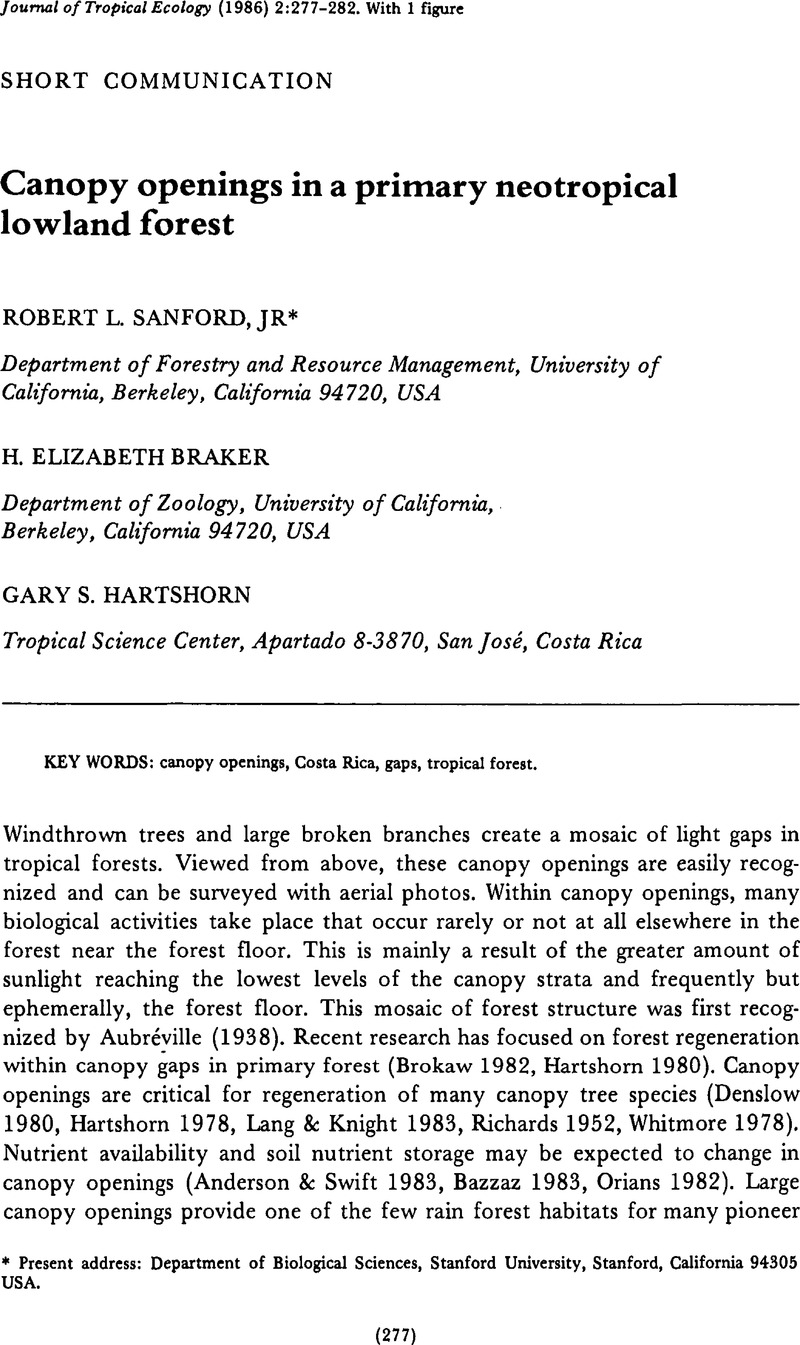Crossref Citations
This article has been cited by the following publications. This list is generated based on data provided by Crossref.
Proctor, John
1987.
Tropical rain forest.
Progress in Physical Geography: Earth and Environment,
Vol. 11,
Issue. 3,
p.
406.
Schmidt, Wolfgang
1989.
Progress in Botany.
p.
350.
Sanford, Robert L.
1989.
Fine root biomass under a tropical forest light gap opening in Costa Rica.
Journal of Tropical Ecology,
Vol. 5,
Issue. 2,
p.
251.
Barton, Andrew M.
Fetcher, Ned
and
Redhead, Steven
1989.
The relationship between treefall gap size and light flux in a Neotropical rain forest in Costa Rica.
Journal of Tropical Ecology,
Vol. 5,
Issue. 4,
p.
437.
Sharpe, Joanne M.
and
Jernstedt, Judith A.
1990.
LEAF GROWTH AND PHENOLOGY OF THE DIMORPHIC HERBACEOUS LAYER FERN DANAEA WENDLANDII (MARATTIACEAE) IN A COSTA RICAN RAIN FOREST.
American Journal of Botany,
Vol. 77,
Issue. 8,
p.
1040.
Sanford, Robert L.
1990.
Fine root biomass under light gap openings in an Amazon rain forest.
Oecologia,
Vol. 83,
Issue. 4,
p.
541.
Levey, Douglas J.
1990.
Habitat-dependent fruiting behaviour of an understorey tree,Miconia centrodesma, and tropical treefall gaps as keystone habitats for frugivores in Costa Rica.
Journal of Tropical Ecology,
Vol. 6,
Issue. 4,
p.
409.
Newell, Elizabeth A.
McDonald, Evan P.
Strain, Boyd R.
and
Denslow, Julie S.
1993.
Photosynthetic responses of Miconia species to canopy openings in a lowland tropical rainforest.
Oecologia,
Vol. 94,
Issue. 1,
p.
49.
Loiselle, Bette A.
and
Blake, John G.
1993.
Frugivory and seed dispersal: ecological and evolutionary aspects.
p.
177.
Loiselle, Bette A.
and
Blake, John G.
1993.
Spatial distribution of understory fruit-eating birds and fruiting plants in a neotropical lowland wet forest.
Vegetatio,
Vol. 107-108,
Issue. 1,
p.
177.
Brown, Nick
1993.
The implications of climate and gap microclimate for seedling growth conditions in a Bornean lowland rain forest.
Journal of Tropical Ecology,
Vol. 9,
Issue. 2,
p.
153.
Ashton, P S
1993.
The community ecology of Asian rain forests, in relation to catastrophic events.
Journal of Biosciences,
Vol. 18,
Issue. 4,
p.
501.
Steege, Hans Ter
Bokdam, Carla
Boland, Miranda
Dobbelsteen, Jose
and
Verburg, Ivo
1994.
The effects of man made gaps on germination, early survival, and morphology ofChlorocardium rodieiseedlings in Guyana.
Journal of Tropical Ecology,
Vol. 10,
Issue. 2,
p.
245.
Poorter, Lourens
Jans, Luc
Bongers, Frans
and
Van Rompaey, Renaat S. A. R.
1994.
Spatial distribution of gaps along three catenas in the moist forest of Taï National Park, Ivory Coast.
Journal of Tropical Ecology,
Vol. 10,
Issue. 3,
p.
385.
Lieberman, Milton
Lieberman, Diana
Peralta, Rodolfo
and
Hartshorn, Gary S.
1995.
Canopy closure and the distribution of tropical forest tree species at La Selva, Costa Rica.
Journal of Tropical Ecology,
Vol. 11,
Issue. 2,
p.
161.
Yavitt, Joseph B.
Battles, John J.
Lang, Gerald E.
and
Knight, Dennis H.
1995.
The canopy gap regime in a secondary Neotropical forest in Panama.
Journal of Tropical Ecology,
Vol. 11,
Issue. 3,
p.
391.
Meer, P. J.
and
Bongers, F.
1996.
Formation and closure of canopy gaps in the rain forest at Nouragues, French Guiana.
Vegetatio,
Vol. 126,
Issue. 2,
p.
167.
Kitajima, Kaoru
1996.
Tropical Forest Plant Ecophysiology.
p.
559.
Kaspari, Michael
1996.
Litter ant patchiness at the 1-m2 scale: disturbance dynamics in three Neotropical forests.
Oecologia,
Vol. 107,
Issue. 2,
p.
265.
Denslow, Julie S.
1996.
Biodiversity and Ecosystem Processes in Tropical Forests.
Vol. 122,
Issue. ,
p.
127.



